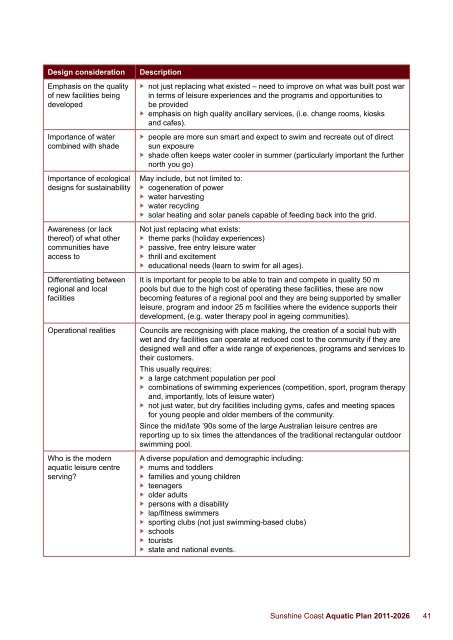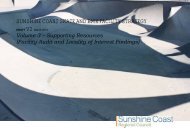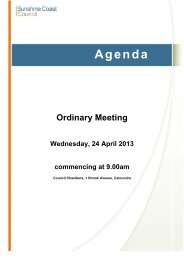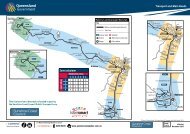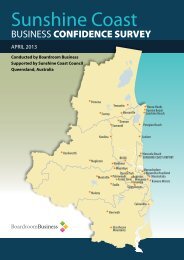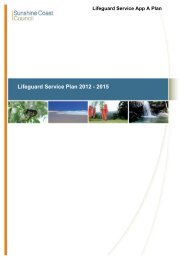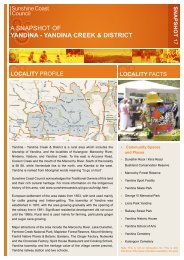Sunshine Coast Aquatic Plan 2011-2026 - Sunshine Coast Council
Sunshine Coast Aquatic Plan 2011-2026 - Sunshine Coast Council
Sunshine Coast Aquatic Plan 2011-2026 - Sunshine Coast Council
You also want an ePaper? Increase the reach of your titles
YUMPU automatically turns print PDFs into web optimized ePapers that Google loves.
Design consideration<br />
Emphasis on the quality<br />
of new facilities being<br />
developed<br />
Importance of water<br />
combined with shade<br />
Importance of ecological<br />
designs for sustainability<br />
Awareness (or lack<br />
thereof) of what other<br />
communities have<br />
access to<br />
Differentiating between<br />
regional and local<br />
facilities<br />
Operational realities<br />
Who is the modern<br />
aquatic leisure centre<br />
serving?<br />
Description<br />
►►<br />
►►<br />
►►<br />
►►<br />
not just replacing what existed – need to improve on what was built post war<br />
in terms of leisure experiences and the programs and opportunities to<br />
be provided<br />
emphasis on high quality ancillary services, (i.e. change rooms, kiosks<br />
and cafes).<br />
people are more sun smart and expect to swim and recreate out of direct<br />
sun exposure<br />
shade often keeps water cooler in summer (particularly important the further<br />
north you go)<br />
May include, but not limited to:<br />
►►<br />
cogeneration of power<br />
►►<br />
water harvesting<br />
►►<br />
water recycling<br />
►►<br />
solar heating and solar panels capable of feeding back into the grid.<br />
Not just replacing what exists:<br />
►►<br />
theme parks (holiday experiences)<br />
►►<br />
passive, free entry leisure water<br />
►►<br />
thrill and excitement<br />
►►<br />
educational needs (learn to swim for all ages).<br />
It is important for people to be able to train and compete in quality 50 m<br />
pools but due to the high cost of operating these facilities, these are now<br />
becoming features of a regional pool and they are being supported by smaller<br />
leisure, program and indoor 25 m facilities where the evidence supports their<br />
development, (e.g. water therapy pool in ageing communities).<br />
<strong>Council</strong>s are recognising with place making, the creation of a social hub with<br />
wet and dry facilities can operate at reduced cost to the community if they are<br />
designed well and offer a wide range of experiences, programs and services to<br />
their customers.<br />
This usually requires:<br />
►►<br />
a large catchment population per pool<br />
►►<br />
combinations of swimming experiences (competition, sport, program therapy<br />
►►<br />
and, importantly, lots of leisure water)<br />
not just water, but dry facilities including gyms, cafes and meeting spaces<br />
for young people and older members of the community.<br />
Since the mid/late ’90s some of the large Australian leisure centres are<br />
reporting up to six times the attendances of the traditional rectangular outdoor<br />
swimming pool.<br />
A diverse population and demographic including:<br />
►►<br />
mums and toddlers<br />
►►<br />
families and young children<br />
►►<br />
teenagers<br />
►►<br />
older adults<br />
►►<br />
persons with a disability<br />
►►<br />
lap/fitness swimmers<br />
►►<br />
sporting clubs (not just swimming-based clubs)<br />
►►<br />
schools<br />
►►<br />
tourists<br />
►►<br />
state and national events.<br />
<strong>Sunshine</strong> <strong>Coast</strong> <strong>Aquatic</strong> <strong>Plan</strong> <strong>2011</strong>-<strong>2026</strong> 41


